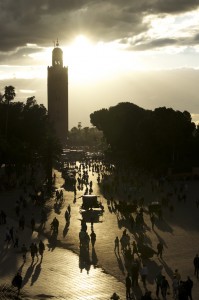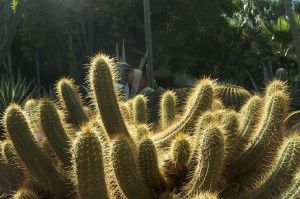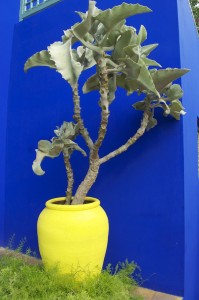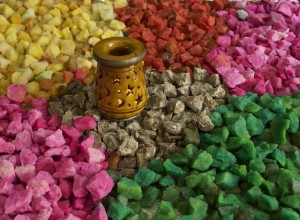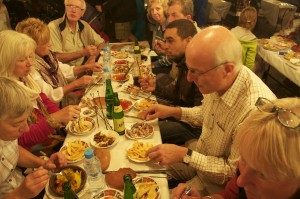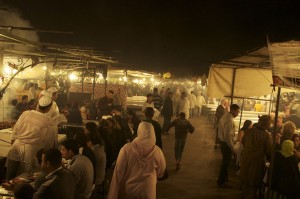As Trevor Lloyd-Adams, Gordon Templeton and I sat in the Bridge bar and restaurant a young, east European waitress came over and asked if we were twins! Okay, so none of us has much hair and we all wear glasses but, other than the fact that all three of us are male, that is where the similarity ends, I think. Those who know us might have an opinion on the matter.
The flight to Casablanca with Royal Air Maroc was quite dull with no entertainment and very slow service. By the time the trolley reached me there was no wine left. The same happened to the rest of the group in the two rows behind. Then, miraculously more wine was to be found for the remaining rows on the flight. I began to wonder whether there was a special clause on our tickets. Annoying as it was, it was not worth making a fuss.
Casablanca is becoming the hub for all flights into Morocco and on arrival we transferred into the ‘cathedral’ of domestic departures, a lofty building with an inverted glass spire hanging down from the ceiling. There were a number of flights in preparation so the building was full, leaving only the floor for us late comers to sit on. Suddenly all flights seemed to be called at once and while sun seekers flew on to Agadir, culture vultures to Rabat or Fez, we, and others heading for the mountains, boarded our plane for the twenty five minute flight to Marrakech.
By the time we had collected our luggage, purchased local currency, met our guide, Mohamed, and transferred to our hotel, Riad Moulay Said, in the heart of the city it was 12.30am. Despite the late hour the streets were full of young men in party mood, Morocco having given Mozambique a 4 – 0 drubbing in a World Cup qualifier.
By 8.30 the following morning, having had breakfast and sorted our kit, we were climbing aboard two minibuses for the two hour drive to the start of our trek in the High Atlas Mountains. En route, we stopped in the last town before the road wound its way into the mountains, to buy enough water for the trek. As soon as we stopped the street hawkers pounced upon us trying to sell jewellery or fossilised stones. They hardly bothered me but some of the group, Calum in particular, seemed to attract them like a magnet. Even when he bought stuff, they still concentrated on him, suggesting that he should buy more.
The final leg of the journey saw us climbing to the small ski resort of Oukaimeden (2700m). It sits in a bowl virtually surrounded on all sides by grassy slopes topped with rocky outcrops. With the exception of flocks of sheep and goats the place is deserted with empty ski apartments, static chair lifts and closed shops and restaurants. Not so long ago this was purely the domain of the seasonal shepherds, with their extremely basic stone summer dwellings dotted about the hillside. Towards the end of November the scene will look very different; all of the shepherds will have migrated with their flocks to the Sahara, the bowl will be full of fresh snow, the whine of the chairlifts will replace the bleating of the sheep and the skiers will bring a new vibrancy to Oukaimeden.
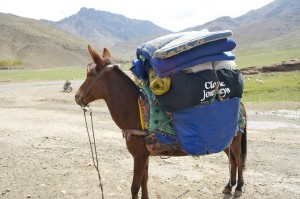
A laden mule with the, now green, ski area behind
As we waited for our kit to be sorted into mule loads, and the mules to be weighed down with all that they had to carry, the hawkers suddenly materialised and latched on to anybody who showed an interest, particularly Calum and Stuart, who weakened after much bargaining.
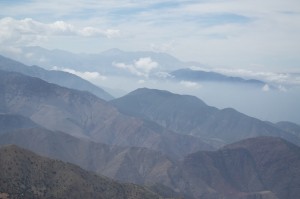
Layers of ridges descending from the High Atlas towards the coastal plains
The walk to camp was only forty minutes as the crow flies, or the laden mule plods, but we took a circuitous ramble around the edge of the valley to enjoy the views, giving the crew time to set up camp. There was no pressure on us. We knew we did not have to go far but it was good to stretch the legs after the travelling. From the ridge we could look across towards Toubkal, although we could not see it hiding behind its neighbours, and we were filled with excitement about being there in a few days.
Reaching camp by mid afternoon, we enjoyed a late lunch of finely chopped salad, olives, couscous, cheese and tinned fish, followed by fresh fruit. All incredibly healthy. The rest of the afternoon was spent exploring the area, poking our noses into the shepherd huts, which have absolutely no home comforts, and looking forward to the trek ahead. As the sun descended dramatically behind Oukaimeden, the temperature dropped significantly. Day turned to night and a myriad of stars filled the skies above us. None of us were late to bed. I think it was a bit of a shock that Morocco, so close to the desert, could be so cold at night. In the morning the bowl of washing water, left out overnight, was a frozen block. It is easy to imagine why this is such a good ski area, for once the snow falls and settles in the bowl it will not go in a hurry.
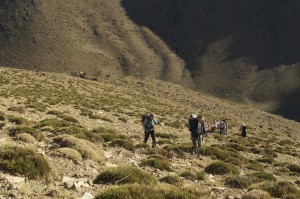
The steep pull up to Jebel Oukaimeden
To help us acclimatise to the altitude on our first full day of trekking, we spent the morning climbing Jebel Oukaimeden (3260m) before returning to camp and lunch and then the onward trek. This started steeply up to a ridge line, which we then followed up to the summit. As we were approaching the summit the chair lift suddenly sprang into action and we imagined the hawkers using it to try to sell us some more jewellery. Fortunately, it turned out to be a maintenance crew coming up to prepare things for the coming ski season.
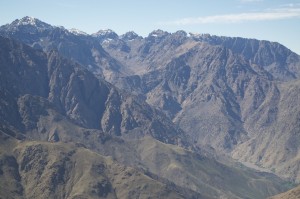
Our trekking area from the summit of Jebel Oukaimeden
From the summit we had superb views towards the higher peaks. It was particularly interesting that we could virtually see all the route that we would be covering over the next few days, down towards Tacheddirt, our next camp, over the Tizi-n-Tamatert Col into the Mizane Valley leading all the way up towards the Neltner Refuge, our high camp for our attack on the summit of Toubkal, a few days hence.
Following another sumptuous lunch we began our afternoon trek to Tacheddirt as clouds began to roll in from the west, at first just enveloping the summits but eventually consuming all around us. We climbed steadily up to the Tizi-n-Eddi Pass (3000m) where a large flock of goats grazed among the rocks. There were clearly a number of boys looking after them and their shouts, whistles and songs could be heard echoing off the invisible crags around the top of the pass. As we descended steeply down the other side, the clouds occasionally parted giving tantalising glimpses of a lush, green valley below.
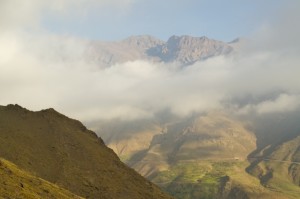
The descent was long varying between steep sections and traverses around crags. We were now out of the ski area and the scenery was that much more dramatic. As the afternoon progressed the clouds around the summits began to clear, leaving a skirt of cloud hugging the lower slopes. The late afternoon sun kissed the rocky summits. It was stunning. By the time we reached Tacheddirt (2300m) the light was fading rapidly and we still had a mile or so to reach camp. The villages in this valley do not allow camping within the village boundary; land is much to precious for farming, so we had to pass through the village to some non agricultural land. Our long day had a sting in the tail as there was a steep climb up to our camp, now approached in the dark.
If it had been chilly overnight in Oukaimeden in was positive warm in Tacheddirt, such a contrast. Before we left camp the following morning, Mohamed advised us not to take photographs of adults and to ask before taking any of children. This was because we were going to come into contact with local people during the morning as we walked through a number of villages hugging the hillside as we dropped down to the village of Ouanesekra before the ascent of Tizi-n-Tematert col. The path took us through narrow village streets and followed irrigation channels feeding lush, green fields and orchards.
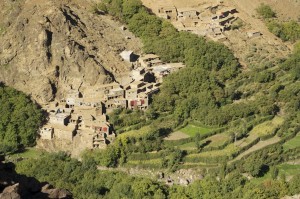
Ouanesekra
There were very few people about. Children were still walking to school but most of the adults were already at work in the fields or within the homes. There was a peaceful tranquility about the valley and it was a delightful walk. As we approached Ouanesekra nestling at the foot of steep slopes in every direction, it was apparent that its peace will soon be spoiled by the road being created to link it with the rest of Morocco. Whilst progress is necessary it seems a shame that such a beautiful place will lose its uniquely peaceful setting to motorised transport.
It was a steady climb up to the pass and there was the reward of an open cafe at the top, particularly welcome as it was such a hot morning with temperatures nudging into the early 30s and the sun beating down from a cloudless sky. It was very crowded at the pass with a large group of students from King’s Canterbury. Following a rest and a drink we began the steep descent into the Mizane Valley through a forest of pine trees. In terms of modernisation, this valley is ahead of its neighbour over the pass. Tourism has brought many benefits, including tarmac, and this is likely to be extended into the valley we had just left. The path criss-crossed the road in several places.
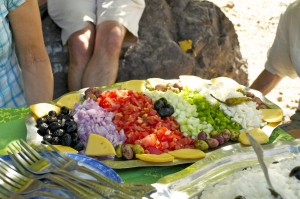
Lunch
We eventually came to a shady glade where our crew were waiting to serve us lunch. Considering the conditions they have to work in and the fact that they have to unload the mules each time, they do a remarkable job. Not only is the quality of food excellent, the presentation is always a piece of art. The meals are also incredibly healthy.
Following lunch we skirted around the hillside to the small, but busy town of Aroumd. For me, we were now on familiar territory, having been here a few years previously. In the Mizane Valley there are not the camping restrictions that we had encountered at Tacheddirt. The Mizane Valley is the main route up to Toubkal so tourism plays an important part in the lives of the villagers. There are many auberge, guest houses and gift shops as well as numerous places to camp. Our camp was just on the edge of the village on the main route up to the mountain and under a canopy of walnut trees.
During the night the wind picked up. The trees above swayed in the gusts while a door nearby banged at regular intervals. Once awake, it was difficult to go back to sleep.
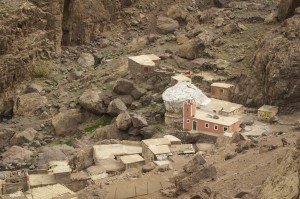
The shrine of Sidi Chamharouch
The gale was still blowing when we set off on our trek up to the Neltner Refuge. This is a long and steady climb, firstly up to the shrine of Sidi Chamharouch nestling in the elbow of the valley, before continuing to the refuge at the head of the valley. As it was so windy we chose not to lunch on the way up but to wait until we reached camp, allowing the crew a little more comfort and guaranteeing we have a dust free lunch.
The rest of the day was spent trying to keep out of the wind and turning our thoughts to the task ahead, the climbing of Toubkal. There was some concern that conditions, should the wind not ease at all, would make the ascent both too difficult and potentially dangerous. Originally, the plan was to leave camp at 4.00am but, because of the conditions, it was decided to delay this until 5.00am. It was also decided that as one member of the team had a knee and back problem, I would take them back down to Aroumd. The severity of the climb in the prevailing conditions was not appropriate. As I had been to the summit before and also had a foot and back problem, it seemed a sensible decision.
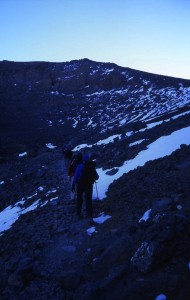
Nearing the top of the long haul up to the ridge, taken on previous climb of Toubkal
At 5.00am the rest of the group left camp for the summit climb, 1000m of steep scree up to the ridge and the eventual pyramid on the summit. The wind was still buffeting camp and would be significantly stronger as they gained height. It is just as well that the start is in the dark; not being able to see the daunting first section has to be a bonus.
Sometimes the body, not only has difficulty adjusting to the altitude but also to the effort required at a time when it should be sleeping and resting. Another member of the team began to have difficulty and was sick. Then all the energy drains from the body and Mohamed sent her down with the crew member acting as a back marker.
Meanwhile the rest continued in an upward direction. However, at about 8.15am, over three hours after leaving camp, three more decided that the effort of the climb and the extreme wind was too much for them. Mohamed chose to leave them sheltering among some rocks, although it was impossible to escape the wind and the cold that it caused. What they achieved in the conditions is incredible, particularly as two of them were trekking virgins.
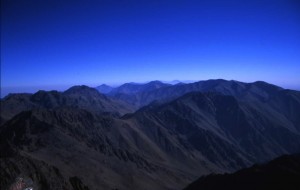
The view SE from the summit, taken on previous climb of Toubkal
The five remaining members of the team, including a third trekking virgin, continued to the summit, eventually reaching it. Remarkably, there was very little wind, a place of peace and calm with all the mayhem taking place below. Reaching the summit was only half the job done. They now had to get down, picking up the three sheltering, who by now were extremely cold, and trek all the way down to Aroumd. There was no chance to relax until they at least reached the refuge where they would join up with the sick member of the team who had come down earlier in the day.
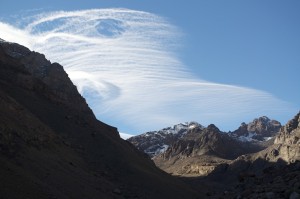
Clouds of change over Toubkal
Meanwhile, I was heading back down the valley when I looked back and saw a change in the weather just beginning to develop. There was a fascinating cloud forming over the summit area. While it looked innocuous, I instinctively knew it was a prelude to changing conditions. What mattered was how quickly that change would take place. Would the rest of the group get off the mountain and would they get back to camp in time?
On reaching camp, a few tent sized platforms on the hillside up valley from Aroumd, at the same time as the crew and mules, we helped set up camp. The wind seemed to be dying and while clouds gathered over the tops, the sun shone fiercely on us in camp while we worked. Having eaten a late lunch, we rested, firstly on a rock, but once the sun had gone as the clouds formed, then in our tents. The afternoon progressed into evening, the light began to fade, we became enveloped in cloud rising from the valley below and it began to rain. We watched as people came down but none of them were part of our group. Eventually, at 7.00pm, fourteen hours after leaving camp, they group returned, very tired but happy. Their mood suggested they had all reached the summit but, despite only five having done so, I think they were all satisfied with their performances and achievements.
It rained all night in camp, snowed higher up, and the rain continued well into the morning. The snow line, we learned, was just above the shrine and on the upper slopes there could be anything up to a metre of snow. It is highly unlikely that many more will succeed in reaching North Africa’s highest point this season. I wondered if the start of the ski season in Oukaimeden was being brought forward.
I have always said that these trips are a journey and that it is not about the summit but about the getting there and back that is important. If you reach the summit it is a bonus but it must never be considered the be all and end all. Any way, we had more of a journey to enjoy yet. We still had Marrakech to come.

